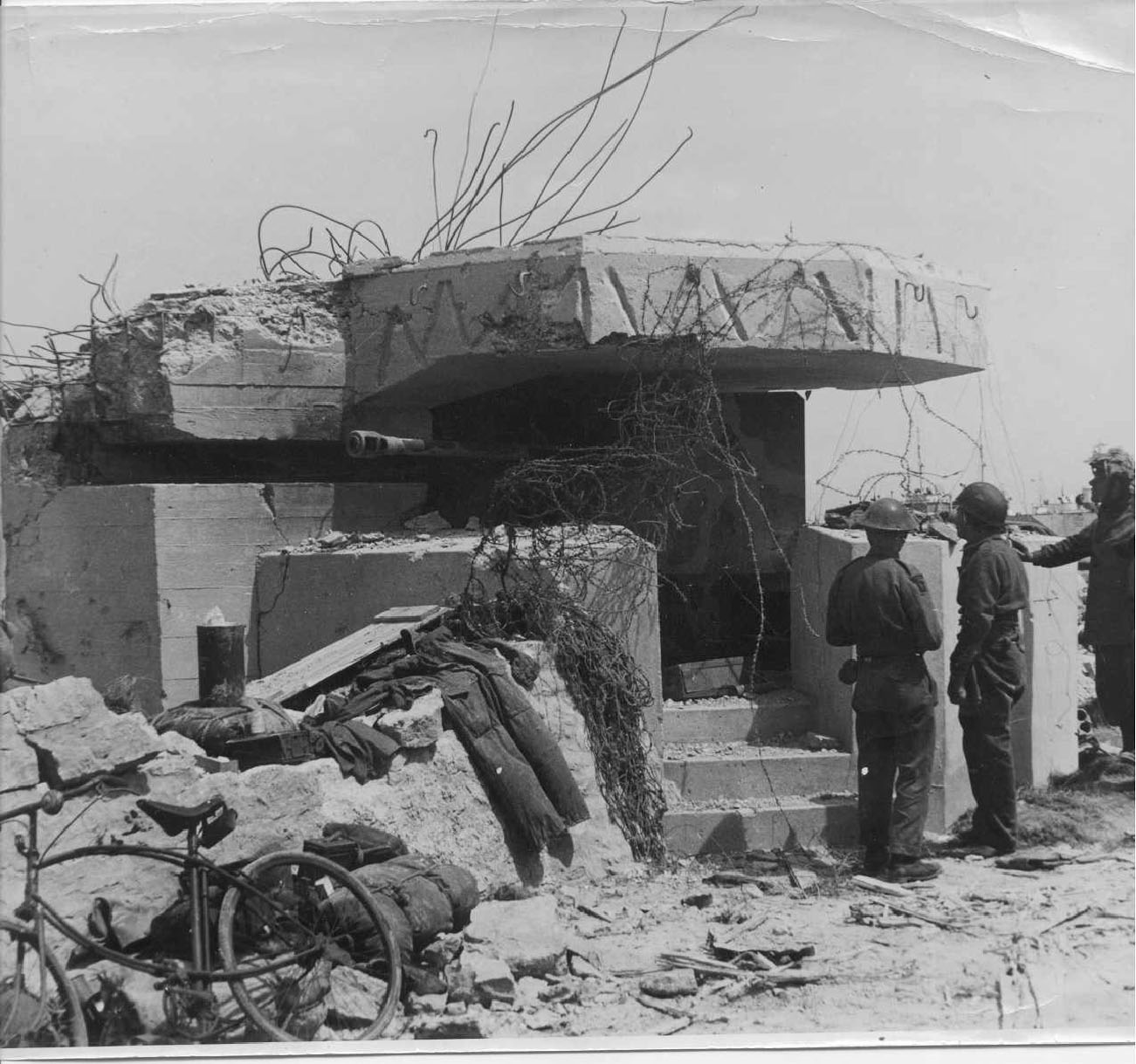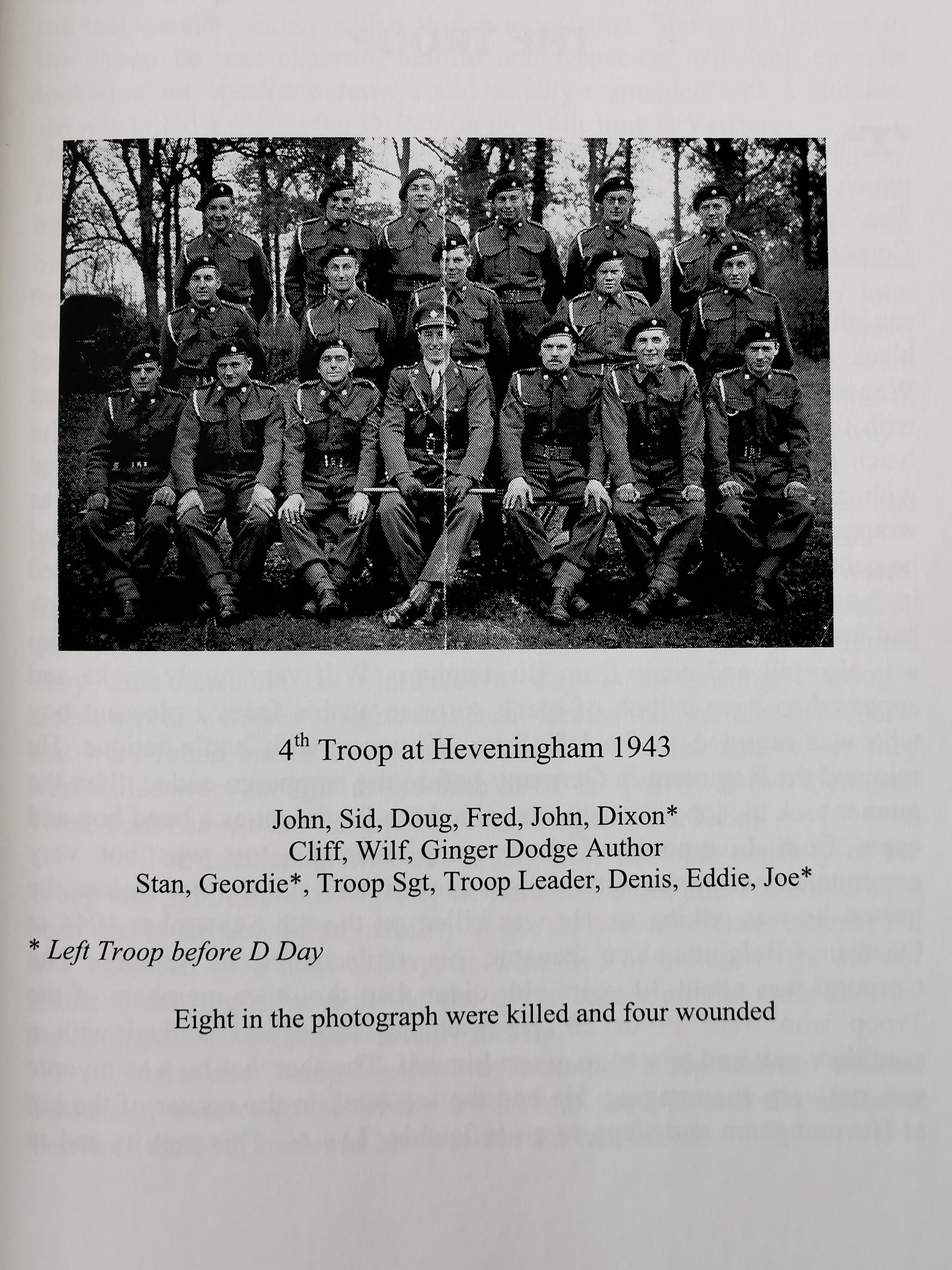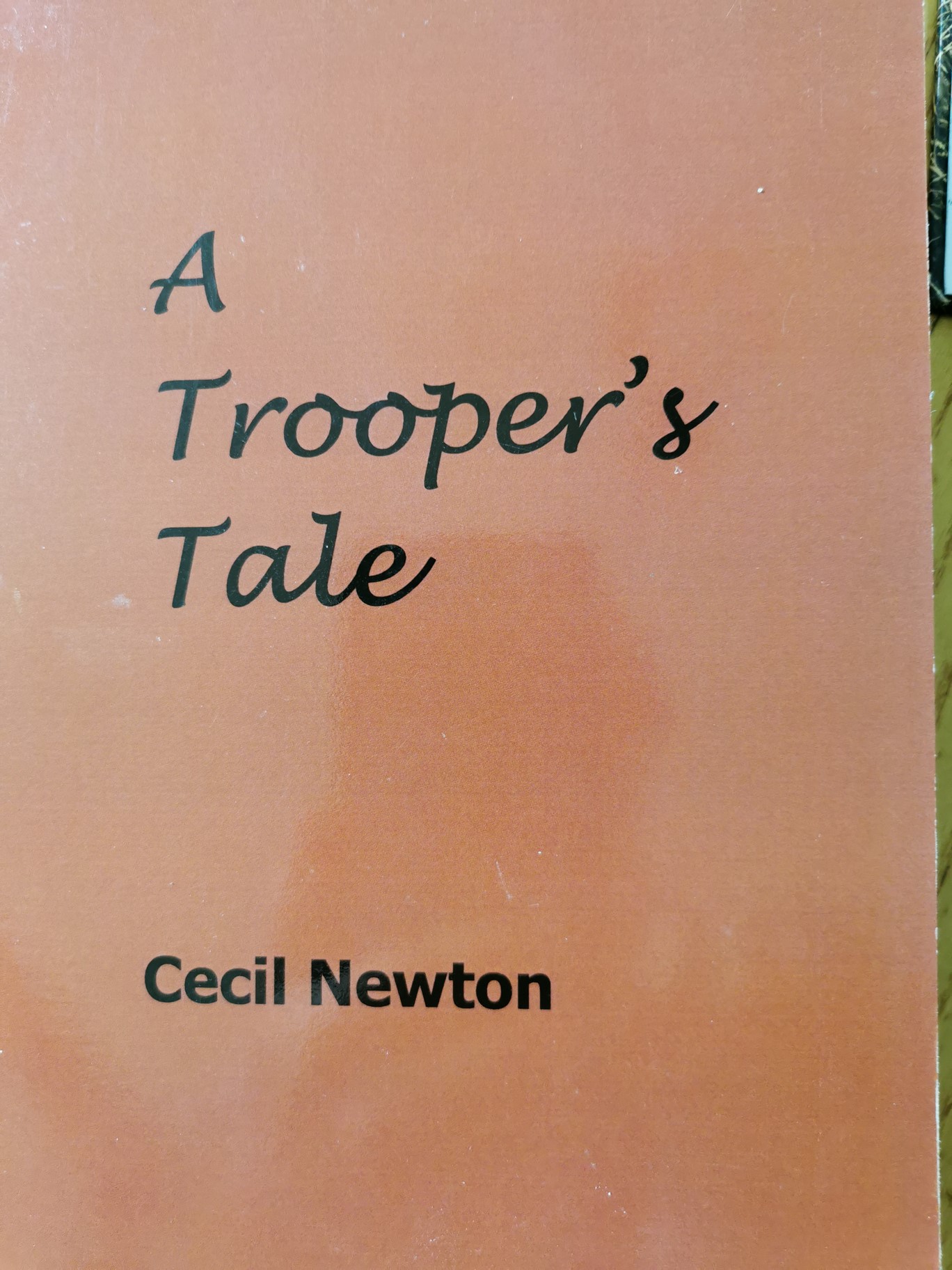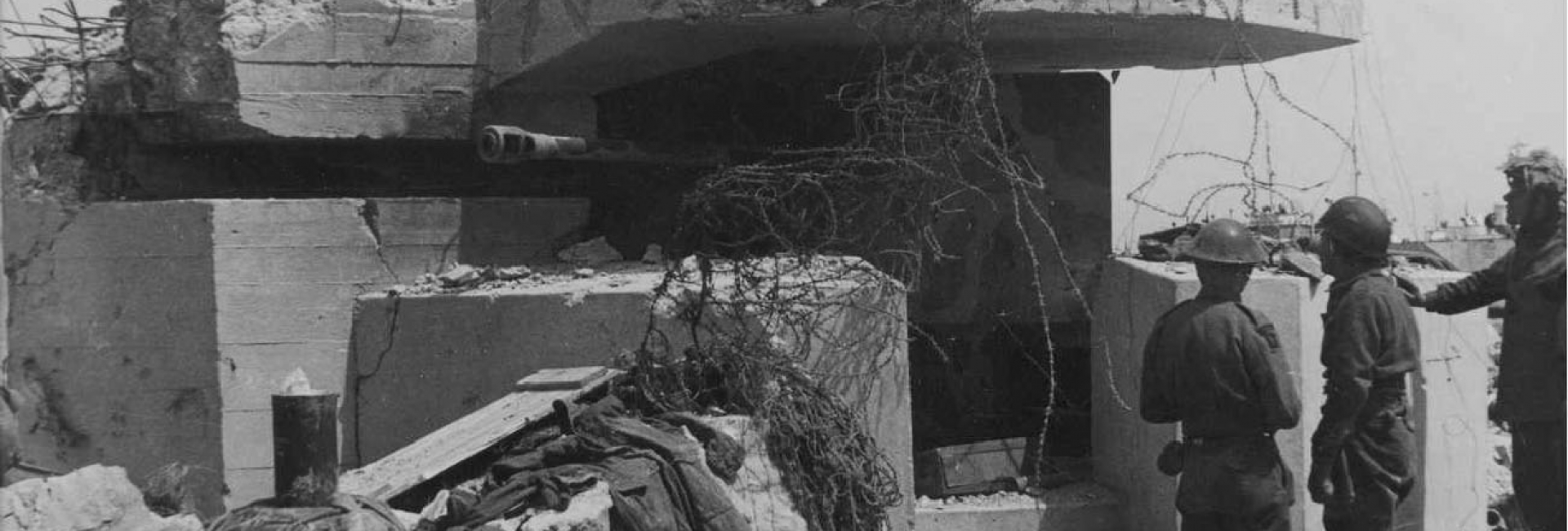There has s been no other enterprise in the past or most likely will be in the future as D Day; it was so well organised and was so successful. The task of landing on a hostile and well defended shore, transporting 132,815 troops across the Channel together with the vehicles and materiel was a colossal achievement. The landing area extended from Ouistreham (the port for Caen) in the east to the Cherbourg Peninsula in the west and was divided into Sword, Juno, Gold, Omaha and Utah Beaches.
Perhaps at no other time has innovation and invention been so fertile, including General Hobart’s ‘Funnies’. These were adaptations of armoured vehicles to provide a variety of uses and one was the Duplex Drive amphibious tank to assist the infantry in the landing. These Shermans transformed into boats by means of a high canvas screen that could be raised around the tank's superstructure and two propellers at the back. It was with these DD tanks that ‘B’ and ‘C’ Squadrons of our regiment, the 4 th /7 th Royal Dragoon Guards, were equipped.
There were five crew in a Sherman, and three tanks in a troop - the Troop Leader’s tank, Sergeant’s and Corporal’s each accompanied by a driver, co-driver, gunner and gunner operator. I was a Trooper and a gunner operator, who loaded the guns and operated the wireless set. I served in 4 th Troop ‘B’ Squadron.
We undertook extensive training in different parts of the UK. We sailed the Valentine DD tank, the precursor of the Sherman DD, in Southampton Water landing at Bembridge Point. There were also night exercises, the tank fitted with a mast and navigation lights, and there was an exercise off Tain in Scotland and also in Studland Bay. What the exercises proved was that the DD tank was very vulnerable in rough weather. A tank from our Troop sank at the exercise in Scotland and also at Studland, but luckily because of the Amphibious Tank Escape Apparatus the crew survived. However, because of a storm that arose at Studland, five further tanks sank and six crew members drowned. A plaque at Fort Henry commemorates the tragic event and a service is held there each year on 4 th April.
In late April 1944, we went by lorry to a camp at Lepe, Hampshire where we took delivery of the Sherman DD tanks. We were accommodated in Bell tents in an open area on a hill overlooking the sea. The huts for administration and messing were in the woods behind. The tanks were in a copse at the foot of the hill and we spent our time getting them ready for service. Units of the Manchester Regiment guarded the camp and a briefing was given in a guarded marquee. Towards the end of May we heard the camp was to be sealed so we took the opportunity one weekend to go ‘Absent without Leave’, packing the beds to resemble recumbent forms, circumnavigated the guards and walked during the night to Southampton where we caught the train home in the early morning. For some this was the last time that they saw their loved ones. There is a commemorative plaque at Lepe to the 124 from the 4 th /7 th Royal Dragoon Guards who did not return to these shores and a service will be held on Sunday 1 st June this year.
On the sunny afternoon of 3 rd June ‘B’ and ‘C’ Squadron’s Sherman DD tanks were loaded on to Tank Landing Crafts with a mission for our three tanks to capture an unidentifiable structure on the French coast. The structure turned out to be a large blockhouse capable of firing its gun enfilade down each side of the beach, traversing rear. The beach was Gold Beach at the small town of Ver-sur-Mer.
The craft remained in the Solent for 4th June. D-Day was to take place on 5th June, but was postponed because of very bad weather to 6 th June. That night we moored off the Needles alongside a much larger ship dimly discernible in the black night as a darker sheet of blackness.
The crossing was extremely rough and we were extremely sick. We arrived off the coast of France, the coast line a grey streak above a slate coloured turbulent sea. The landing was to be H Hour - 7.25 am and the DD tanks were due on the beach at H minus 5 minutes to support the incoming infantry.
The whole fleet of ships and landing craft were waiting for the order to open the barrage and land the assault troops. A rocket ship opened fire next to us and we followed the Troop Sergeant’s tank down the landing craft's ramp and threaded our way through the sea defences towards the blockhouse which was clearly visible on the shoreline. We had been dropped nearer to the coast than originally intended since it was too rough for the tanks to swim in, motoring along the sea bed instead.
Our screen was lowered as we stood off in the shallows and engaged the blockhouse with our 75mm using H.E. (high explosive ammunition). An infantry man has subsequently said that a shell whistled through the aperture of the blockhouse.
The crew of the blockhouse decided to call it a day and came out, lining up in front with their hands up. There were about six Germans in shirtsleeves, the commander standing in the centre of the line wearing a peaked cap - all no doubt according to the rulebook. Our Troop Leader was awarded the Military Cross and the Troop Sergeant the Military Medal for the capture of the blockhouse.
Our tank became swamped and we made valiant attempts to get it out, up to our waists in the sea amidst the crash of explosions, but to no avail. We rescued our belongingsfrom the tank including the cooker so we could have a cup of tea.
On the incoming tide the bodies of two young Royal Marines rolled about in the surf at the side of the blockhouse. Out at sea a soldier squatted on a submerged craft waiting for rescue. When I looked again he had gone.
There was a lull after the assault troops had left the beach to advance inland. Stretcher-bearers were methodically picking up the corpses and placing them in rows with feet towards the sea; one row for the British and a separate row for the Germans with their boots protruding. The bodies were covered with a large black tarpaulin the end of which they turned back to receive another body.
The afternoon was quiet, a few troops pottered about. In the minefield a ‘Flail’ tank was clearing mines. I picked up an abandoned folding bike and went for a spin
We eventually met up with our lorries and went inland stopping in a meadow for the night. I wrapped myself in a blanket and placed my tin hat on my head for protection. I watched the tracer bullets from anti- aircraft defences on the beach reaching out into the sky and dropped off into a sound sleep.
Casualties from original and reinforcements of the 15 who landed - 10 killed, 7 wounded, 2 POWs (2 of those killed were 19 years of age) Tanks from original 3 and replacements - 1 swamped and 7 destroyed by enemy action
Cecil Newton 18 th May 2020
Perhaps at no other time has innovation and invention been so fertile, including General Hobart’s ‘Funnies’. These were adaptations of armoured vehicles to provide a variety of uses and one was the Duplex Drive amphibious tank to assist the infantry in the landing. These Shermans transformed into boats by means of a high canvas screen that could be raised around the tank's superstructure and two propellers at the back. It was with these DD tanks that ‘B’ and ‘C’ Squadrons of our regiment, the 4 th /7 th Royal Dragoon Guards, were equipped.
There were five crew in a Sherman, and three tanks in a troop - the Troop Leader’s tank, Sergeant’s and Corporal’s each accompanied by a driver, co-driver, gunner and gunner operator. I was a Trooper and a gunner operator, who loaded the guns and operated the wireless set. I served in 4 th Troop ‘B’ Squadron.
We undertook extensive training in different parts of the UK. We sailed the Valentine DD tank, the precursor of the Sherman DD, in Southampton Water landing at Bembridge Point. There were also night exercises, the tank fitted with a mast and navigation lights, and there was an exercise off Tain in Scotland and also in Studland Bay. What the exercises proved was that the DD tank was very vulnerable in rough weather. A tank from our Troop sank at the exercise in Scotland and also at Studland, but luckily because of the Amphibious Tank Escape Apparatus the crew survived. However, because of a storm that arose at Studland, five further tanks sank and six crew members drowned. A plaque at Fort Henry commemorates the tragic event and a service is held there each year on 4 th April.
In late April 1944, we went by lorry to a camp at Lepe, Hampshire where we took delivery of the Sherman DD tanks. We were accommodated in Bell tents in an open area on a hill overlooking the sea. The huts for administration and messing were in the woods behind. The tanks were in a copse at the foot of the hill and we spent our time getting them ready for service. Units of the Manchester Regiment guarded the camp and a briefing was given in a guarded marquee. Towards the end of May we heard the camp was to be sealed so we took the opportunity one weekend to go ‘Absent without Leave’, packing the beds to resemble recumbent forms, circumnavigated the guards and walked during the night to Southampton where we caught the train home in the early morning. For some this was the last time that they saw their loved ones. There is a commemorative plaque at Lepe to the 124 from the 4 th /7 th Royal Dragoon Guards who did not return to these shores and a service will be held on Sunday 1 st June this year.
On the sunny afternoon of 3 rd June ‘B’ and ‘C’ Squadron’s Sherman DD tanks were loaded on to Tank Landing Crafts with a mission for our three tanks to capture an unidentifiable structure on the French coast. The structure turned out to be a large blockhouse capable of firing its gun enfilade down each side of the beach, traversing rear. The beach was Gold Beach at the small town of Ver-sur-Mer.
The craft remained in the Solent for 4th June. D-Day was to take place on 5th June, but was postponed because of very bad weather to 6 th June. That night we moored off the Needles alongside a much larger ship dimly discernible in the black night as a darker sheet of blackness.
The crossing was extremely rough and we were extremely sick. We arrived off the coast of France, the coast line a grey streak above a slate coloured turbulent sea. The landing was to be H Hour - 7.25 am and the DD tanks were due on the beach at H minus 5 minutes to support the incoming infantry.
The whole fleet of ships and landing craft were waiting for the order to open the barrage and land the assault troops. A rocket ship opened fire next to us and we followed the Troop Sergeant’s tank down the landing craft's ramp and threaded our way through the sea defences towards the blockhouse which was clearly visible on the shoreline. We had been dropped nearer to the coast than originally intended since it was too rough for the tanks to swim in, motoring along the sea bed instead.
Our screen was lowered as we stood off in the shallows and engaged the blockhouse with our 75mm using H.E. (high explosive ammunition). An infantry man has subsequently said that a shell whistled through the aperture of the blockhouse.
The crew of the blockhouse decided to call it a day and came out, lining up in front with their hands up. There were about six Germans in shirtsleeves, the commander standing in the centre of the line wearing a peaked cap - all no doubt according to the rulebook. Our Troop Leader was awarded the Military Cross and the Troop Sergeant the Military Medal for the capture of the blockhouse.
Our tank became swamped and we made valiant attempts to get it out, up to our waists in the sea amidst the crash of explosions, but to no avail. We rescued our belongingsfrom the tank including the cooker so we could have a cup of tea.
On the incoming tide the bodies of two young Royal Marines rolled about in the surf at the side of the blockhouse. Out at sea a soldier squatted on a submerged craft waiting for rescue. When I looked again he had gone.
There was a lull after the assault troops had left the beach to advance inland. Stretcher-bearers were methodically picking up the corpses and placing them in rows with feet towards the sea; one row for the British and a separate row for the Germans with their boots protruding. The bodies were covered with a large black tarpaulin the end of which they turned back to receive another body.
The afternoon was quiet, a few troops pottered about. In the minefield a ‘Flail’ tank was clearing mines. I picked up an abandoned folding bike and went for a spin
We eventually met up with our lorries and went inland stopping in a meadow for the night. I wrapped myself in a blanket and placed my tin hat on my head for protection. I watched the tracer bullets from anti- aircraft defences on the beach reaching out into the sky and dropped off into a sound sleep.
Casualties from original and reinforcements of the 15 who landed - 10 killed, 7 wounded, 2 POWs (2 of those killed were 19 years of age) Tanks from original 3 and replacements - 1 swamped and 7 destroyed by enemy action
Cecil Newton 18 th May 2020
Opération Epsom

Trooper s tale

Trooper s tale





